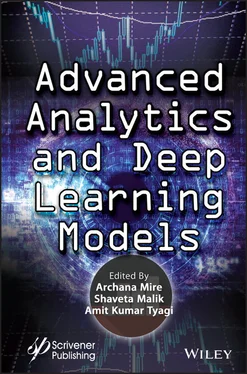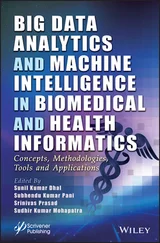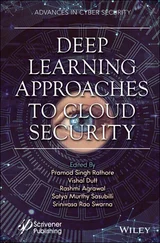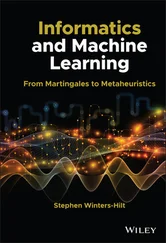Advanced Analytics and Deep Learning Models
Здесь есть возможность читать онлайн «Advanced Analytics and Deep Learning Models» — ознакомительный отрывок электронной книги совершенно бесплатно, а после прочтения отрывка купить полную версию. В некоторых случаях можно слушать аудио, скачать через торрент в формате fb2 и присутствует краткое содержание. Жанр: unrecognised, на английском языке. Описание произведения, (предисловие) а так же отзывы посетителей доступны на портале библиотеки ЛибКат.
- Название:Advanced Analytics and Deep Learning Models
- Автор:
- Жанр:
- Год:неизвестен
- ISBN:нет данных
- Рейтинг книги:5 / 5. Голосов: 1
-
Избранное:Добавить в избранное
- Отзывы:
-
Ваша оценка:
- 100
- 1
- 2
- 3
- 4
- 5
Advanced Analytics and Deep Learning Models: краткое содержание, описание и аннотация
Предлагаем к чтению аннотацию, описание, краткое содержание или предисловие (зависит от того, что написал сам автор книги «Advanced Analytics and Deep Learning Models»). Если вы не нашли необходимую информацию о книге — напишите в комментариях, мы постараемся отыскать её.
The book provides readers with an in-depth understanding of concepts and technologies related to the importance of analytics and deep learning in many useful real-world applications such as e-healthcare, transportation, agriculture, stock market, etc.
Audience
Advanced Analytics and Deep Learning Models — читать онлайн ознакомительный отрывок
Ниже представлен текст книги, разбитый по страницам. Система сохранения места последней прочитанной страницы, позволяет с удобством читать онлайн бесплатно книгу «Advanced Analytics and Deep Learning Models», без необходимости каждый раз заново искать на чём Вы остановились. Поставьте закладку, и сможете в любой момент перейти на страницу, на которой закончили чтение.
Интервал:
Закладка:
AI promotes personalized and autonomous learning. With the integration of AI, students always have easy access to learning. They can study at their own pace and space. They can study at any place and time they wish to. Students can clear their doubts at their own speed and time with AI-powered chatbots or AI virtual personal assistants like Google Assistant and Siri, without being humiliated in front of the entire class. AI personalizes studies to meet the needs of individual students, resulting in increased efficiency. AI has the potential to personalize digital language learning make for each learner, catering to their individual needs.
1.6.2 Produce Smart Content
The use of AI in education has paved the way for modern learning methods such as visualization, simulation, and web-based learning environments. Learners become more involved and engaged as a result of these new learning methods. Not only that, but AI also assists in the development and updating of lesson material, as well as customizing it for various learning goals and learners.
1.6.3 Task Automation
Evaluation is a time-consuming task that could be easily automated by the instructor using AI. It can automatically grade tests and even review essays, highlighting mistakes and recommending ways to prevent them in the future.
1.6.4 Access to Education for Students with Physical Disabilities
The innovative integration of AI in education broadens the ways of building multitude of constructive pedagogies to teaching and learning for students having learning disabilities. It also ensures access to education for physically challenged students like deaf or visually impaired. AI systems can be effectively trained to assist any group of special needs students.
1.7 Conclusion
If we look back in the timeline, we would realize that AI that we are living today was just a part of science fiction movies some years ago. Today, AI has become an inseparable part of our lives and it has made its space in almost all the spheres we can think of, right from business, banking, health, aviation to marketing, and now is slowly paving its way in the sphere of academics. AI in education is playing a significant role in augmenting teaching and learning. AI learning platforms facilitate autonomous learning, provides flexibility of space, pace, and time. Further, it facilitates personalized learning focusing on the learners’ interest areas and considering the factors such as strengths, weaknesses, interests, and cultural background. AI-integrated online learning has augmented second language education across the globe manifolds.
Despite of AI having an enormous potential of enhancing the teaching and learning of foreign or second language, it still have certain challenges which need to be addressed. According to Lovett, despite advances in translation technology, there have been questions regarding Google Translate’s grammatical accuracy and how it might be impacting the learner’s process of building proficiency [34]. Furthermore, NLP is a complicated process, and accurately capturing all linguistic information is difficult. Further, the voice recognition also needs adjustments as sometimes it cannot understand heavy accents, articulation speech impediments, and soft voices. Therefore, further studies can be done to identify the solutions to the above stated problems. In addition, further research can also be done to identify the impact of AI on personalized learning, the grammar of the target language and on the proficiency of the language learnt. Moreover, a study on assessing the efficiency of AI on grading and evaluation can also be done.
AI is slowly paving its way into the sphere of academics through various technologies like Machine Learning and NLP, and it is surely going to foster the teaching and learning of second and foreign languages in the days to come.
References
1. Warschauer, M., Of digital divides and social multipliers: Combining language and technology for human development, in: Information and communication technologies in the teaching and learning of foreign languages: State of the art, needs and perspectives , p. 46, 2004.
2. Khan, N.M. and Kuddus, K., Integrating ICT in English Language Teaching in Bangladesh: Teachers’ Perception and Challenges. Rupkatha J. Interdiscip. Stud. Humanit. , 12, 5, 1, 2020.
3. Chatterjee, B. and Kuddus, K., Second Language Acquisition through Technology: A Need for Underdeveloped Regions like Jharkhand. Res. Sch.-An International Referred e- J. Lit. Explor. , 2, 2, 252, 2014.
4. Kuddus, K., Emerging Technologies and the Evolving Roles of Language Teachers: An Overview. Lang. India , 18, 81, 2018.
5. Kannan, J. and Munday, P., New trends in second language learning and teaching through the lens of ICT, networked learning, and artificial intelligence, in: Vías de transformación en la enseñanza de lenguas con mediación tecnológica. Círculo de Lingüística Aplicada a la Comunicación , vol. 76, Fernández Juncal, C. and Hernández Muñoz, N. (Eds.), p. 13, 2018, http://dx.doi.org/10.5209/CLAC.62495.
6. Davies, G., Walker, R., Rendall, H., Hewer, S., Introduction to new technologies and how they can contribute to language learning and teaching (CALL). Module 1.1, in: Information and Communications Technology for Language Teachers (ICT4LT) , G. Davies (Ed.), Thames Valley University, Slough, 2011, http://www.ict4lt.org/en/en_mod1-1.htm.
7. Levy, M., CALL: context and conceptualisation , Oxford: Oxford University Press, New York, 1997.
8. Warschauer, M., CALL for the 21st century. Paper presented at the IATEFL and ESADE Conference , Barcelona, Spain, 2 July, 2000, http://education.uci.edu/uploads/7/2/7/6/72769947/cyberspace.pdf.
9. Davies, G., Otto, S.E., Rüschoff, B., Historical perspectives on CALL, in: Contemporary computer-assisted language learning , p. 19, 2013.
10. Kuddus, K., Web 2.0 Technology in Teaching and Learning English as a Second Language. Int. J. Engl. Lang. Lit. , 1, 4, 292, 2013.
11. Dash, A. and Kuddus, K., Leveraging the Benefits of ICT Usage in Teaching of English Language and Literature, in: Smart Intelligent Computing and Applications. Smart Innovation, Systems and Technologies , vol. 160, S. Satapathy, V. Bhateja, J. Mohanty, S. Udgata (Eds.), pp. 225–232, Springer, Singapore, 2020.
12. Chatterjee, B. and Kuddus, K., Mass media Approach to Second Language Acquisition. J. Engl. Stud. , 10, 1, 10, 2015.
13. Warschauer, M. and Kern, R., Network-based language teaching: Concepts and practice , Cambridge University Press, New York, 2000.
14. Sharples, M., Taylor, J., Vavoula, G., A theory of learning for the mobile age, in: Medienbildung in neuen Kulturräumen , pp. 87–99, VS Verlag für Sozialwissenschaften, Switzerland, 2010.
15. Jones, C., Networked learning: an educational paradigm for the age of digital networks , Springer, Cham, Switzerland, 2015.
16. Manns, UNESCO, Artificial Intelligence: Opportunities, threats and the future of learning , Asia and Pacific Regional Bureau for Education, UNESCO Bangkok 2017.
17. Goksel, N. and Bozkurt, A., Artificial Intelligence in Education: Current Insights and Future Perspectives, in: Handbook of Research on Learning in the Age of Transhumanism , Sisman-Ugur, S. and Kurubacak, G. (Eds.), p. 224, 2019.
18. Russell, S.J., and Norvig, P., Artificial intelligence, A modern approach , 2 nded, Pearson Education Inc., Upper Saddle River, New Jersey, 2003.
19. Housman, M., Why ‘augmented intelligence’ is a better way to describe AI , AINews, United Kingdom, 2018, https://www.artificialintelligence-news.com/2018/05/24/why-augmented-intelligence-is-a-betterway-to-describe-ai/.
Читать дальшеИнтервал:
Закладка:
Похожие книги на «Advanced Analytics and Deep Learning Models»
Представляем Вашему вниманию похожие книги на «Advanced Analytics and Deep Learning Models» списком для выбора. Мы отобрали схожую по названию и смыслу литературу в надежде предоставить читателям больше вариантов отыскать новые, интересные, ещё непрочитанные произведения.
Обсуждение, отзывы о книге «Advanced Analytics and Deep Learning Models» и просто собственные мнения читателей. Оставьте ваши комментарии, напишите, что Вы думаете о произведении, его смысле или главных героях. Укажите что конкретно понравилось, а что нет, и почему Вы так считаете.












